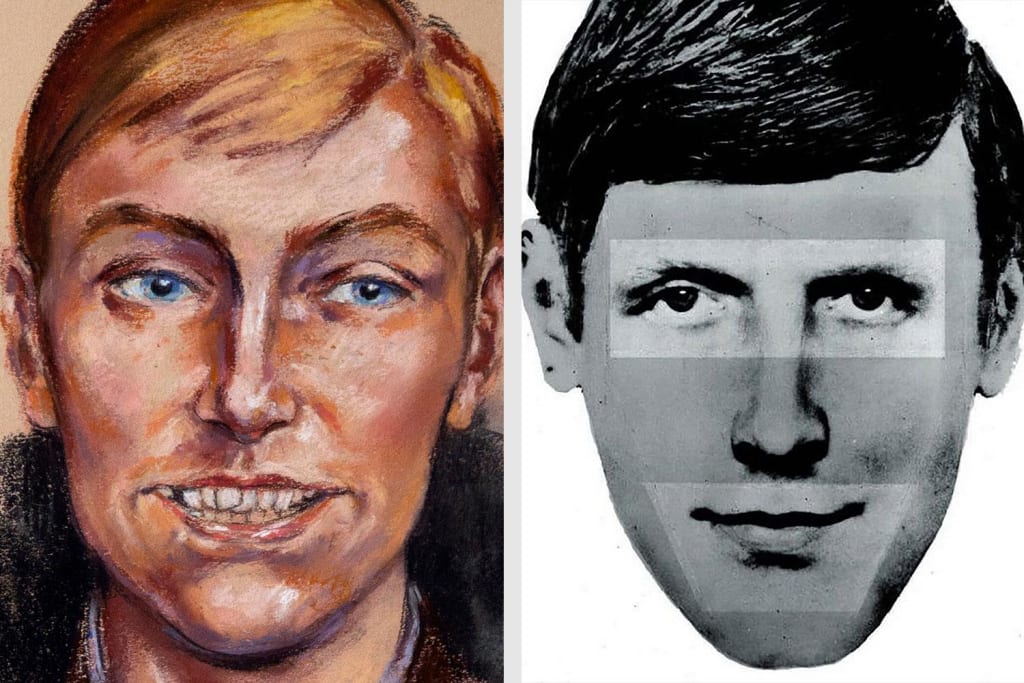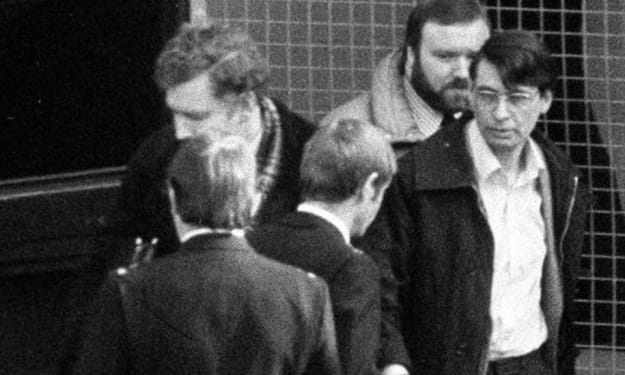
Patricia Docker, Jemima MacDonald, and Helen Puttock had gone out for a night at Glasgow's Barrowland Ballroom. They left their children at home in the care of their family.
They never returned home.
They were strangled and their bodies were dumped just a short distance from where they lived.
This raised fears of a serial killer being on the loose, preying on women. The search for the killer led to Scotland's biggest manhunt. Soon the killer was known as Bible John, this was due to a witness saying he quoted scripture.
Some reported facts about the case were incorrect, a major mistake was saying that all three women were raped, and smaller mistakes being Jemima's age and misspelling of her surname.
And shockingly, detectives described the women as being "highly promiscuous," "Fond of male company," and "Liking attention of men." All misogynistic claims. The victims were being judged and blamed for what had happened to them, all because they had gone out dancing, had a drink, and possibly flirted with men.
Patricia Charlotte Wilson Docker, 25-Years-Old

Patricia, daughter of a Royal Air Force electronics engineer, John Wilson, and wife, Pauline.
She lived in Gloucestershire as a child, until August 1953 when she boarded the P&O troopship Empire Orwell with her mother. They were heading to Singapore where Flt Lt Wilson was stationed. Later on the family moved to a large house in Glasgow.
She married Alexander Docker when she was 19, he was a senior aircraftman with the RAF. They had one son together named Sandy. The family lived in Cyprus, where Alexander's unit was based.
They had a family babysitter, Yiannoulla, who described Patricia as a very nice lady. Also saying that she would dress up very nice, wearing skirts, blouses, and a suit.
She also recalled taking beach trips with Sandy and how she and Patricia would watch a TV show called Dr. Kildare, they both wanted to be nurses.
But, Patricia's marriage was in trouble, after the Cyprus posting, the two separated.
In April 1967, Patricia returned to Glasgow, she became an auxiliary nurse and worked nights and split her shifts and care of now four-year-old Sandy with her mother.
Once a week, she would take a night off from her responsibilities to go dancing, the police report on her death is written in the same judgmental, misogynistic language that was used to describe each woman.
It said that she "appears to enjoy the company of men" and also described her as "an only child and apparently rather spoiled."
There's little detail to what happened after she left the flat she shared with her parents and son in the Langside area of the city.
She wore a mustard-knitted dress and a duffle coat with a blue fur collar. When her body was discovered, she was lying by the door of a garage in a residential lane, her clothes were nowhere to be seen.
Her son's life was upended when his mother was murdered, he was called Alex around this time. He was driven from Glasgow by his father, who was now stationed at RAF Digby and had a new partner.
Jemima Ramsay Gibson MacDonald, 31-Years-Old

On the night of Jemima's death, she was dressed in a frilly blouse and a pinafore dress. Her body was found by her sister, she was found lying in a derelict building next door to the tenement flat that she shared with her three children.
But, Jemima's story seems to have disappeared with the tenement building. She loved dancing and came from a big family, but other than that, little is known.
The police also said her eldest child was a girl, Elizabeth, who was age 11 at the time. Her father was a Yugoslav, according to notes. Jemima also had two sons, Andrew, 8, and Allan, 7, their father was said to be a West Indian. Police notes also say: "Jemima appeared to be clean in her person and her home, and her children were well cared for."
After Jemima's murder, child welfare officials took Elizabeth to a residential care home and her brothers were taken to a different care home. One day they were living with her mother across the road from their aunt, the next they were separated and living in care homes.
Helen Gowans Puttock, 29-Years-Old

Helen went to Barrowland with her big sister Jean the night she was murdered. Her story has the most detail since there was a crucial, surviving witness. But, there is still little known about her life.
In 1996, Jean was interviewed, she said that she would call her sister Ellen and that she was good-looking and loved dancing.
On the day that they went to Barrowland, Helen had gone to C&A and purchased a black dress with gold buttons. Jean said her sister was tall, well-dressed, and that her new dress was lovely. She wore it on the night she died, along with a fake-fur ocelot-print coat.
Helen worked on the buses and was a furrier and a bookie. When she had a romance break up, she went down to stay with her brother in Reading. This was where she met her husband, George Puttock, he was a lance corporal in the Royal Corps of Signals. They married in March 1964, at age 23-years-old.
The two of them had two children, David and Michael. And when George got stationed in Germany, his family followed. But, Helen disliked it there and decided to move back to Glasgow to live with her mother in Mid-March 1969.
Helen told George their marriage was over, he ended up travelling to the city on his next leave from the army on October 17th, hoping he could win back his wife. But Helen told him she didn't love him anymore.
Jean was in the taxi along with Helen and the man she left the Barrowland with on the night of her murder. This is the man that police believed to have killed Helen.
Jean recalled that the man quoted small bits from the Bible and claimed his name was John. These are the details that media collected, so the name "Bible John," was created.
Helen's cousin, Elaine Paterson, said that the family was left broken after what had happened, "It ruined the whole family," She said, "George took the kids away, down to England, so old Jeannie [Helen's mother] not only lost her daughter, she lost her grandkids. And Jean lost a sister."
Helen's body had been left in a backyard, eight doors away from her mother's top-floor flat.
Investigation
The investigation of Bible John became one of the largest ever carried out by Scottish police.
More than 5,000 people were interviewed. They also used a police photofit of the suspect was used.
No arrests were made, however. And one suspect's body was exhumed after the case was reopened in 1995. But he was eliminated after the tests failed to find a DNA link to the killings.
One potential new suspect is a man who was working in a laboratory at Glasgow's Royal Infirmary, but he left the city to live in Dublin before returning in the early 70s.
"This man came from a very religious background, he told co-workers he frequented the dance halls during the weekends and his face was remarkably similar to the photofit, not the painting but the original image," A source said, "His behavior was increasingly bizarre and worrying and he got into trouble a few times. He died in the mid 70sm having killed himself in the most awful of manners. Bible John was said to have told Helen Puttock and Jeannie Langford he worked in a lab."
But, the mystery remains to who Bible John truly is.
About the Creator
Shelby
Just a girl who loves to write about paranormal and life stuff. Please enjoy






Comments
There are no comments for this story
Be the first to respond and start the conversation.